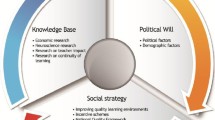Abstract
Unlike many countries throughout the world, USA is relatively new to the scene in early childhood education as a federal and state policy. It is only in recent years that policymakers have turned to early childhood as a critical factor in children’s education. This chapter attempts to describe the current state of affairs in our policy efforts, and to reflect on our challenges in establishing a better safety net for our children at risk. To do so, I briefly describe our current policy priorities. I then move to examine the major types of programs serving our young children and then offer recommendations for the future.
Access this chapter
Tax calculation will be finalised at checkout
Purchases are for personal use only
Similar content being viewed by others
References
Barnett, W. S., Brown, K., & Shore, R. (2004). The universal Vs. targeted debate: Should the United States have preschool for all? new brunswick. NJ: NIEER.
Children’s Defense Fund. (2004). The state of America’s children. Washington, DC: Children’s Defense Fund.
Gormley, W., Gayer, T., Phillips, D., & Dawson, B. (2005). The effects of universal pre-k on cognitive development. Developmental Psychology, 41(6), 872–884.
Hart, B., & Risley, T. (1995). Meaningful differences. Baltimore, MD: Brookes.
Heckman, J. (2000). Invest in the very young. Washington, DC: Ounce of Prevention Fund.
Love, J., Kisker, E., Ross, C., Schochet, P., Brooks-Gunn, J., Paulsell, D., Brady-Smith, C. (2002). Making a difference in the lives of infants and toddlers and their families: The impacts of early head start. executive summary. Washington, DC: Administration on Children, Youth, and Families, U.S. Department of Health and Human Services.
Neuman, S. B. (2007). Changing the odds for children at risk. Educational Leadership, 65(2), 16–21.
Olds, D., Kitzman, H., Cole, R., Robinson, J., KSidora, K., Luckey, D., et al. (2004). Effects of nurse home-visiting on maternal life course and child development: Age 6 follow-up results of a randomized trial. Pediatrics, 114, 1550–1559.
Pianta, R., Bryant, D., Clifford, R., Early, D., & Barbarian, O. (2005). Features of pre-kindergarten programs, classrooms, and teachers: Do they predict observed classroom quality and child-teacher interactions? Applied Developmental Science, 9(3), 144–159.
Puma, M., Bell, S., Cook, R., & Heid, C. (2010). Head start impact study. Washington, DC: U.S Department of Health and Human Services, Administration for Children and Families Final Report.
Raikes, H., Green, B., Atwater, J., Kisker, E., Constantine, J., & Chazan-Cohen, R. (2006). Involvement in early head start home visiting services: Demographic predictors and relations to child and parent outcomes. Early Childhood Research Quarterly, 21, 2–24.
Ramey, S. L., & Ramey, C. (2006). Early educational interventions: Principles of effective and sustained benefits from targeted early education programs. In D. Dickinson & S. B. Neuman (Eds.), Handbook of early literacy research (Vol. II, pp. 445–459). New York: Guilford.
Weiland, C., & Yoshikawa, H. (2013). Impacts of a prekindergarten program on children’s mathematics, language, literacy, executive function, and emotional skills. Child Development, 84(6), 2112–2130.
Wright, T., & Neuman, S.B. (in press). Paucity and disparity in oral vocabulary instruction in kindergarten. Journal of Literacy Research.
Zaslow, M., & Martinez-Beck, I. (Eds.). (2006). Critical issues in early childhood professional development. Baltimore, MD: Brookes.
Author information
Authors and Affiliations
Corresponding author
Editor information
Editors and Affiliations
Rights and permissions
Copyright information
© 2015 Springer-Verlag Berlin Heidelberg
About this chapter
Cite this chapter
NEUMAN, S.B. (2015). Describing the Early Childhood Policy Landscape in the USA. In: HUO, L., B. NEUMAN, S., NANAKIDA, A. (eds) Early Childhood Education in Three Cultures. New Frontiers of Educational Research. Springer, Berlin, Heidelberg. https://doi.org/10.1007/978-3-662-44986-8_4
Download citation
DOI: https://doi.org/10.1007/978-3-662-44986-8_4
Published:
Publisher Name: Springer, Berlin, Heidelberg
Print ISBN: 978-3-662-44985-1
Online ISBN: 978-3-662-44986-8
eBook Packages: Humanities, Social Sciences and LawEducation (R0)




